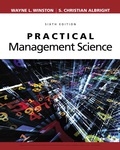
Concept explainers
It is January 1 of year 0, and Merck is trying to determine whether to continue development of a new drug. The following information is relevant. You can assume that all cash flows occur at the ends of the respective years.
- Clinical trials (the trials where the drug is tested on humans) are equally likely to be completed in year 1 or 2.
- There is an 80% chance that clinical trials will succeed. If these trials fail, the FDA will not allow the drug to be marketed.
- The cost of clinical trials is assumed to follow a triangular distribution with best case $100 million, most likely case $150 million, and worst case $250 million. Clinical trial costs are incurred at the end of the year clinical trials are completed.
- If clinical trials succeed, the drug will be sold for five years, earning a profit of $6 per unit sold.
- If clinical trials succeed, a plant will be built during the same year trials are completed. The cost of the plant is assumed to follow a triangular distribution with best case $1 billion, most likely case $1.5 billion, and worst case $2.5 billion. The plant cost will be depreciated on a straight-line basis during the five years of sales.
- Sales begin the year after successful clinical trials. Of course, if the clinical trials fail, there are no sales.
- During the first year of sales, Merck believe sales will be between 100 million and 200 million units. Sales of 140 million units are assumed to be three times as likely as sales of 120 million units, and sales of 160 million units are assumed to be twice as likely as sales of 120 million units.
- Merck assumes that for years 2 to 5 that the drug is on the market, the growth rate will be the same each year. The annual growth in sales will be between 5% and 15%. There is a 25% chance that the annual growth will be 7% or less, a 50% chance that it will be 9% or less, and a 75% chance that it will be 12% or less.
- Cash flows are discounted 15% per year, and the tax rate is 40%.
Use simulation to model Merck’s situation. Based on the simulation output, would you recommend that Merck continue developing? Explain your reasoning. What are the three key drivers of the project’s
Want to see the full answer?
Check out a sample textbook solution
Chapter 11 Solutions
Practical Management Science
- Question 2 (25 Marks) Discuss how you would "reset the store estate" to remain competitive and relevant in the market? Question 3 (25 Marks)arrow_forwardWhat should leaders do after conducting an employee survey? take immediate action on results take at least 6 months to review the results to make sure the leader understands them review them immediately, but do not take action right away keep results confidential from employeesarrow_forwardOne of the best ways to encourage teamwork is to: continually promote from outside of the department recognize employees who focus on their personal performance goals only reward employees who complete their own tasks and also assist with problems outside of their department discuss individual performance issues at staff meetingsarrow_forward
- What can happen if a leader doesn't encourage teamwork? team members will support each other more the environment can become overly competitive and hostile turnover will descrease team members become more motivatedarrow_forwardunderstand 4 Classwork LSC Drag the name of the figure of speech to its example. 12 February 2025 personification Onomatopoeia Simile Metaphor Hyperbole Onomatopoeia metaphor 1. He tried to help but his legs were wax. Metaphor 2. The man flights like a lion on the soccer field. Simile 3. The books fell on the table with a loud thump. Onomatopoeia 4. Rita heard the last piece of pie calling her name. Personification 5. The rustling leaves kept me away. Personification 6. Kisses are the flowers of affection. 7. He's running faster than the windarrow_forwardAnswer the question in the attached photo and draw the network that interprets the dataarrow_forward
- not use ai pleasearrow_forwardoimmnjjjharrow_forwardSummarize the ethical dilemma encountered in Walmart Inc. Which of Kohlberg's stages of moral development is represented? Is there other theories of moral development that better describes the example? Postulate the (hypothetical or real) best- and worst-case outcomes of this dilemma. Is it agreeable with the selection of Kohlberg's stages of moral development for their examples? Is there another theory of moral development that would better describe their examples?arrow_forward
- Four-drive theory recommends that companies must keep fulfillment of the four drives in balance. What is this “balance” and why is it important? Can you Give an example (real or hypothetical) of how a company maintains balanced drive fulfillment. Also describe a company that does not provide this balance, including the consequences of this imbalance on employees’ attitudes and behavior. Thank youarrow_forwardwhat criteria would you utilize to determine if someone's pay is “fair” or “egregious?” Additionally, what should be the mechanism or process to determine how much greater an organizational executive should be paid versus line-level employees?arrow_forwardDefine the concept of a compensation philosophy, including the components that should be addressed in a compensation philosophy. Assess why a compensation philosophy is so foreign to most organizations and how you can best encourage an organization to create its own compensation philosophy that is beneficial to attracting the best talent.arrow_forward
 Practical Management ScienceOperations ManagementISBN:9781337406659Author:WINSTON, Wayne L.Publisher:Cengage,
Practical Management ScienceOperations ManagementISBN:9781337406659Author:WINSTON, Wayne L.Publisher:Cengage,
